Once apon a time I thought making and selling Mel’s Wax would be a foundational activity for me in “retirement.” I believed the product invented for the archival care of furniture and wooden artifacts while we were together at the Smithsonian would grow into a prominent role at The Barn (half of any proceeds go to Mel’s widow.) The custom-designed performance and formulation was unlike anything else available to furniture caretakers, and one major player in the home care products market whom we approached to manufacture it declared it to be (when cutting through the corporate-ese) “…the best product of its kind we have ever seen, but we have too much invested in our own brand to pursue it.”
Instead it has become a minor amusement for me as there seems to be little interest in the product. Admittedly this might be because I will not turn it over to some third party for production and marketing. It is a fussy product to make, and its applications may be too niche. We found that every potential producer who tried to make it cut corners and substituted more “convenient” ingredients (read: cheaper) or made other modifications to the formula and process to the disadvantage of the product concept and performance.
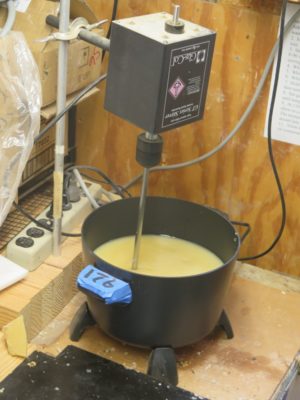
So, instead of working at anything near my capacity of a one-man shop, even if expanding that to a one-man-and-his-really-smart-wife, I find myself making batch (28 units) every so often. Last year while mail-order businesses boomed in general, I sold exactly 17 units. This year is better, having outsold 2020 by a factor of three already, so I was needing to make another batch last week, the third one this year! Normally I make it during the winter when things are cool in the shop (I keep it around 60) but we are now in the throes of a heat wave (low 80s).
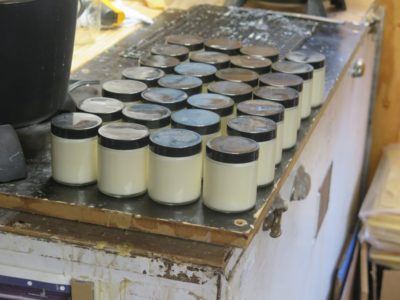
While making the batch it seemed “off” and I set it aside for several days to settle down (sometimes it takes a while for the emulsion to fully set). When I checked back a week later it was still “off” (had not settled into the “lotion” viscosity) and I wondered if ambient heat was the issue. I’ve placed it in the basement of the barn (60 degrees) to set for a day or two and I will check it again. If I still do not like it I will make a whole new batch.
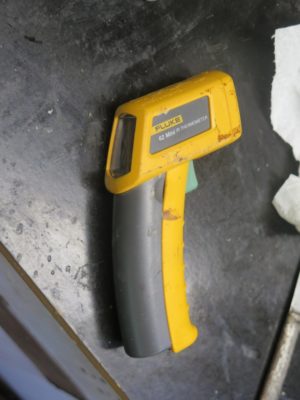
Aside from the digital analytical scales I use to get the ingredient proportions correct, the most important tool in the process is a laser thermometer. Ramping up the temperature and (as important, if not more so) ramping the temperature down is vital to making Mel’s Wax.
This episode not only made me go, “Hmmm,” but reminded me how finicky it is to make.
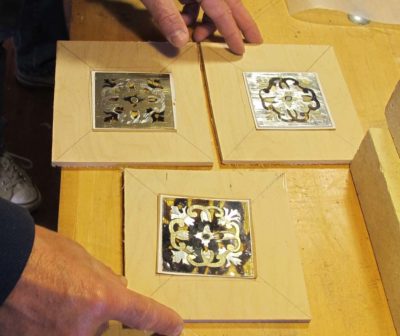
I’ve signed on as one of the speakers for a Spring 2022 conference at the Winterthur Museum on the subject of marquetry. Like many other events over the past two years it has been scheduled, cancelled and re-scheduled, to the point where I am not fully informed myself. (In 2020, 13 of my 13 teaching and speaking gigs were cancelled. It was quite delightful to not travel much, hunkering down in Shangri-la instead [“social isolation” is any day ending in “Y” here in the hinterboonies]) I believe it is in late April but don’t hold me to that. I won’t discuss the other speakers yet as I think the Program is still being finalized, but my presentation and subsequent publication will be on the topic of Boullework.
I have already sketched out my presentation/demonstration in my mind, bringing it into realm of reality will occur over the next eight months. That progress will be documented periodically on this screen.
This is a demonstration-heavy gathering, so if the topic interests you it would be a great opportunity to interact with some very passionate and accomplished folks, both on the stage and in the audience.
Winterthur is a few miles north of I-95 in northern Delaware. I worked there while going through college and have many fond memories of it, both the grounds and museum are magnificent.
Stay tuned.
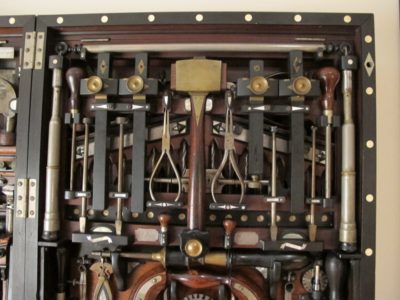 Examining the original mallet in HO Studley’s tool ensemble and comparing it to the foundry practices I was taught 40+ years ago, several things came clearly(?) into focus. First and foremost, this might be the most exquisite sand casting I’ve ever seen. Certainly it was way better than anything our foundry produced, and I think we had a top-of-the-heap casting quality. On the iron/steel side of things the foundry could produce excellent castings up to a 10,000 pound heat size, and on the brass/bronze side the limit was about 600 pounds. The molders were first rate and experienced, the Pour Masters had been doing it since the Mezozoic Age, but even then our castings were nothing like that evident on Studley’s mallet.
Examining the original mallet in HO Studley’s tool ensemble and comparing it to the foundry practices I was taught 40+ years ago, several things came clearly(?) into focus. First and foremost, this might be the most exquisite sand casting I’ve ever seen. Certainly it was way better than anything our foundry produced, and I think we had a top-of-the-heap casting quality. On the iron/steel side of things the foundry could produce excellent castings up to a 10,000 pound heat size, and on the brass/bronze side the limit was about 600 pounds. The molders were first rate and experienced, the Pour Masters had been doing it since the Mezozoic Age, but even then our castings were nothing like that evident on Studley’s mallet.
Admittedly we were making industrial machinery where surface finish was generally of little importance, so we might have used a coarser sand than was used for the mallet head. I believe it came directly from the sand with minimal clean-up and it is glorious. (Alternately the surface was worked — cutting off sprues and gates, etc. — and then bead blasted, but the level of crisp detail remaining might argue against that. Since I was not allowed to disassemble the mallet head [this could not have been accomplished without completely destroying the object, a sorta Studleyesque version of the Heisenberg Uncertainty Principle] much of my thinking at this point is pure conjecture because I cannot make direct observations).

Of my hundreds of images of the mallet, the one shows the casting “seam” most clearly (my foundry’s term for this was “the flashing line”). My main question to myself is, “Do I want to make this exactly as did the original patternmaker and foundryman, or do I make the way most in keeping with my own experience?”
As a patternmaker, and I am currently working up the patterns for casting the infill mallet head myself, I was struck by the orientation of Studley’s mallet casting. My history and inclinations would lead me to make the casting as though the mallet was laying down flat, in other words splitting the pattern and the casting along a vertical plane dividing the casting roughly in half. The Studley mallet casting was turned 90 degrees from the way I would do it, and required the core (the block of sand that occupies the empty internal space) to be inserted into the floor and ceiling of the sand mold rather than laid in the dividing line of the mold.
As I move forward I will blog about all of this in great detail, probably more than you ever wanted to know.
Stay tuned.
With the detachable post vise finished I moved over to the opposite edge of the bench slab and installed a twin screw vise.

Unlike previous versions of the bench outfitting I’ve seen, I decided to cheat a little and use Roubo’s method of making it rather than the Roman version, as demonstrated in his veneer sawing bench from Plate 278 from L’art du Menuisier.
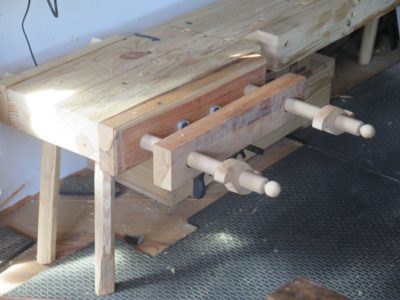
The projecting screws on the Roman version looked like a cracked kneecap waiting to happen. The true Roman version would have looked a bit like this mock-up, featuring a gift vise from my pal Derek Olson. Thanks a ton Derek. I use the vise/press a fair bit in the shop for veneer work, but as a feature of a low bench? No thanks. I’ve limped enough as it is (actually I am now walking without any limp for the first time since forever).
Instead, I drilled a horizontal 1-3/8″ hole into the edge of the slab, then tapped it with my Beale threading tap. I used a Forstner bit with an extension to get the depth of hole I wanted, about seven inches.
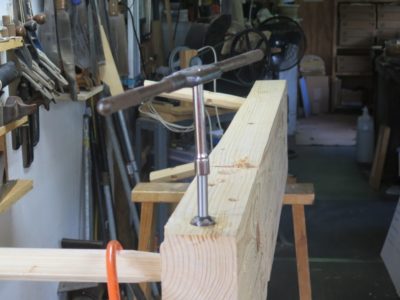
The tap was likewise too short for the hole so I augmented my tap handle with an extender from my 1/2″ ratchet set, which fit the end of the tap perfectly.

As the need arises I will drill and tap holes all the way down the edge of the bench so that I can put the twin-screw vise wherever I need it. The beauty of a low bench is that it is omnidirectional in use. If the vise is on the wrong side I just stand up, rotate my kiester, re-straddle the bench and sit back down to work.

Given the nature of the smaller Kindle case I was making for Mrs. Barn’s 5×7 Kindle, as opposed to my earlier book style case for my own 8×10 Kindle, the assembly and finishing took a different path. Her smaller Kindle led me to create a “calling card case” style container into which the Kindle would be inserted, rather than the bookcase for my larger Kindle, into which the Kindle would be closed within folding panels.

This meant that the process for completing the assembly was entirely different as the interior had to be finished before the case was assembled, rather than after assembly with my case. Making sure the two halves of the case fit precisely I then glued the interior felt lining in place, leaving the case gluing margins clear. However, before I glued in the felt I glued a piece of thin polypropylene foam to the wood panels to assure a gentle pressure on the Kindle once it was slid in to prevent it from falling out due to too loose a fit. Dry fitting the pieces together with the Kindle in place to make sure I had the spacing correct, I then was able to glue the two halves together with PVA making sure to not have excess glue squeezing out into the interior space.
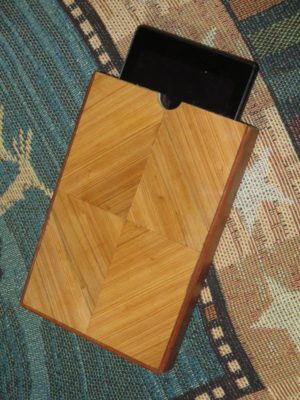
A little trimming and sanding followed by shellac and wax, the case was ready for Christmas and use as she travelled back and forth to the West Coast. Given the unfolding circumstances ex poste, namely the death of her dad in mid-January and our own family Christmas taking place in late February, the case may never be used for its intended purpose of frequent coast-to-coast travel. Nevertheless it was a pleasant and instructive exercise.
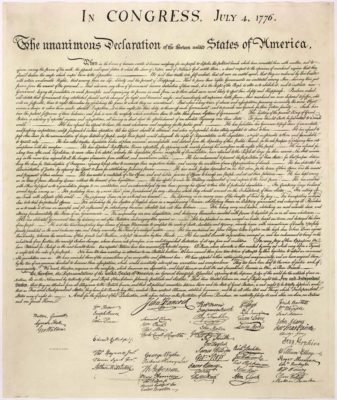
Some version of this post is presented annually at this time. Despite dozens of recitations, I can never read the last line out loud because I am overcome with emotion.- DCW
As our nation is seemingly rife with incurious, gullible and servile inhabitants, we would be well-served to reflect seriously on the document encapsulating the mission statement for the greatest nation ever known to man, the only nation ever founded on a creed rather than geography or lineage. I am unabashedly proud to be a partisan in the cause of Life, Liberty, and Property (the original wording) and find The Declaration to be the most noble civil document ever created by mankind. I pray you will read and reflect on the ideas expressed by men who pledged their lives, their fortunes, and their sacred honor to pursue the path of liberty. Reading it is much like reading the Minor Prophets of the Old Testament; more up-to-date regarding the human condition than tomorrow’s headlines.
========================================================
IN CONGRESS, July 4, 1776.
The unanimous Declaration of the thirteen united States of America,
When in the Course of human events, it becomes necessary for one people to dissolve the political bands which have connected them with another, and to assume among the powers of the earth, the separate and equal station to which the Laws of Nature and of Nature’s God entitle them, a decent respect to the opinions of mankind requires that they should declare the causes which impel them to the separation.
We hold these truths to be self-evident, that all men are created equal, that they are endowed by their Creator with certain unalienable Rights, that among these are Life, Liberty and the pursuit of Happiness.–That to secure these rights, Governments are instituted among Men, deriving their just powers from the consent of the governed, –That whenever any Form of Government becomes destructive of these ends, it is the Right of the People to alter or to abolish it, and to institute new Government, laying its foundation on such principles and organizing its powers in such form, as to them shall seem most likely to effect their Safety and Happiness. Prudence, indeed, will dictate that Governments long established should not be changed for light and transient causes; and accordingly all experience hath shewn, that mankind are more disposed to suffer, while evils are sufferable, than to right themselves by abolishing the forms to which they are accustomed. But when a long train of abuses and usurpations, pursuing invariably the same Object evinces a design to reduce them under absolute Despotism, it is their right, it is their duty, to throw off such Government, and to provide new Guards for their future security.–Such has been the patient sufferance of these Colonies; and such is now the necessity which constrains them to alter their former Systems of Government. The history of the present King of Great Britain is a history of repeated injuries and usurpations, all having in direct object the establishment of an absolute Tyranny over these States. To prove this, let Facts be submitted to a candid world.
He has refused his Assent to Laws, the most wholesome and necessary for the public good.
He has forbidden his Governors to pass Laws of immediate and pressing importance, unless suspended in their operation till his Assent should be obtained; and when so suspended, he has utterly neglected to attend to them.
He has refused to pass other Laws for the accommodation of large districts of people, unless those people would relinquish the right of Representation in the Legislature, a right inestimable to them and formidable to tyrants only.
He has called together legislative bodies at places unusual, uncomfortable, and distant from the depository of their public Records, for the sole purpose of fatiguing them into compliance with his measures.
He has dissolved Representative Houses repeatedly, for opposing with manly firmness his invasions on the rights of the people.
He has refused for a long time, after such dissolutions, to cause others to be elected; whereby the Legislative powers, incapable of Annihilation, have returned to the People at large for their exercise; the State remaining in the mean time exposed to all the dangers of invasion from without, and convulsions within.
He has endeavoured to prevent the population of these States; for that purpose obstructing the Laws for Naturalization of Foreigners; refusing to pass others to encourage their migrations hither, and raising the conditions of new Appropriations of Lands.
He has obstructed the Administration of Justice, by refusing his Assent to Laws for establishing Judiciary powers.
He has made Judges dependent on his Will alone, for the tenure of their offices, and the amount and payment of their salaries.
He has erected a multitude of New Offices, and sent hither swarms of Officers to harrass our people, and eat out their substance.
He has kept among us, in times of peace, Standing Armies without the Consent of our legislatures.
He has affected to render the Military independent of and superior to the Civil power.
He has combined with others to subject us to a jurisdiction foreign to our constitution, and unacknowledged by our laws; giving his Assent to their Acts of pretended Legislation:
For Quartering large bodies of armed troops among us:
For protecting them, by a mock Trial, from punishment for any Murders which they should commit on the Inhabitants of these States:
For cutting off our Trade with all parts of the world:
For imposing Taxes on us without our Consent:
For depriving us in many cases, of the benefits of Trial by Jury:
For transporting us beyond Seas to be tried for pretended offences
For abolishing the free System of English Laws in a neighbouring Province, establishing therein an Arbitrary government, and enlarging its Boundaries so as to render it at once an example and fit instrument for introducing the same absolute rule into these Colonies:
For taking away our Charters, abolishing our most valuable Laws, and altering fundamentally the Forms of our Governments:
For suspending our own Legislatures, and declaring themselves invested with power to legislate for us in all cases whatsoever.
He has abdicated Government here, by declaring us out of his Protection and waging War against us.
He has plundered our seas, ravaged our Coasts, burnt our towns, and destroyed the lives of our people.
He is at this time transporting large Armies of foreign Mercenaries to compleat the works of death, desolation and tyranny, already begun with circumstances of Cruelty & perfidy scarcely paralleled in the most barbarous ages, and totally unworthy the Head of a civilized nation.
He has constrained our fellow Citizens taken Captive on the high Seas to bear Arms against their Country, to become the executioners of their friends and Brethren, or to fall themselves by their Hands.
He has excited domestic insurrections amongst us, and has endeavoured to bring on the inhabitants of our frontiers, the merciless Indian Savages, whose known rule of warfare, is an undistinguished destruction of all ages, sexes and conditions.
In every stage of these Oppressions We have Petitioned for Redress in the most humble terms: Our repeated Petitions have been answered only by repeated injury. A Prince whose character is thus marked by every act which may define a Tyrant, is unfit to be the ruler of a free people.
Nor have We been wanting in attentions to our Brittish brethren. We have warned them from time to time of attempts by their legislature to extend an unwarrantable jurisdiction over us. We have reminded them of the circumstances of our emigration and settlement here. We have appealed to their native justice and magnanimity, and we have conjured them by the ties of our common kindred to disavow these usurpations, which, would inevitably interrupt our connections and correspondence. They too have been deaf to the voice of justice and of consanguinity. We must, therefore, acquiesce in the necessity, which denounces our Separation, and hold them, as we hold the rest of mankind, Enemies in War, in Peace Friends.
We, therefore, the Representatives of the united States of America, in General Congress, Assembled, appealing to the Supreme Judge of the world for the rectitude of our intentions, do, in the Name, and by Authority of the good People of these Colonies, solemnly publish and declare, That these United Colonies are, and of Right ought to be Free and Independent States; that they are Absolved from all Allegiance to the British Crown, and that all political connection between them and the State of Great Britain, is and ought to be totally dissolved; and that as Free and Independent States, they have full Power to levy War, conclude Peace, contract Alliances, establish Commerce, and to do all other Acts and Things which Independent States may of right do. And for the support of this Declaration, with a firm reliance on the protection of divine Providence, we mutually pledge to each other our Lives, our Fortunes and our sacred Honor.
Button Gwinnett
Lyman Hall
George Walton
William Hooper
Joseph Hewes
John Penn
Edward Rutledge
Thomas Heyward, Jr.
Thomas Lynch, Jr.
Arthur Middleton
John Hancock
Samuel Chase
William Paca
Thomas Stone
Charles Carroll of Carrollton
George Wythe
Richard Henry Lee
Thomas Jefferson
Benjamin Harrison
Thomas Nelson, Jr.
Francis Lightfoot Lee
Carter Braxton
Robert Morris
Benjamin Rush
Benjamin Franklin
John Morton
George Clymer
James Smith
George Taylor
James Wilson
George Ross
Caesar Rodney
George Read
Thomas McKean
William Floyd
Philip Livingston
Francis Lewis
Lewis Morris
Richard Stockton
John Witherspoon
Francis Hopkinson
John Hart
Abraham Clark
Josiah Bartlett
William Whipple
Samuel Adams
John Adams
Robert Treat Paine
Elbridge Gerry
Stephen Hopkins
William Ellery
Roger Sherman
Samuel Huntington
William Williams
Oliver Wolcott
Matthew Thornton

As I move forward with prototypes for producing my line of HO Studley mallets I am aided by a number of different assets. For starters I have in hand almost 20 of the castings from Bill Martley, in a variety of alloys, to work with in taking the rough metal castings to a point of “finished” that I would feel comfortable in providing to interested customers.

Second, I have a boatload of photographic images of the mallet from about every angle possible (it might seem adequate to have several dozen images, but they are never enough). Reviewing them does make me reflect on the unbelievable resource residing in my compewder; between my images and Narayan’s images I have almost 7,500 pictures on my hard drive .[As a snarky aside, I note that on occasion someone on the interwebz requests (or worse, demands!) that Narayan make all the high quality unpublished images available on-line for free, somehow not registering the facts that 1) the images are the creative property of Narayan and/or Chris, and 2) the images are the result of an investment of (literally) tens of thousands of dollars. If you have ever expressed this sentiment, grow up. — DCW]
Third, a topic I will address in a later post, I have several molds made directly from the original mallet.
Finally, and perhaps the strongest impetus foundational to this project, I have the enthusiastic approval of Mister Stewart to proceed with my effort to make replica mallets because, and I quote, “People should be using this mallet.” That endorsement is a great encouragement to me and I will produce a tool and make it available only once I am proud of it bearing my imprimatur. At some point very soon I will embark on designing the logos to be stamped or engraved into the mallet itself.
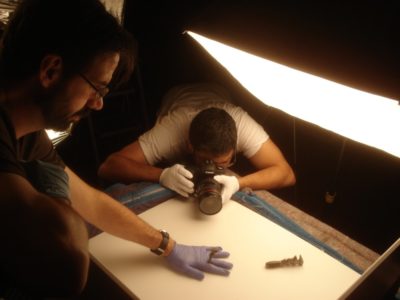
During the many episodes of us examining and photographing the tool cabinet and all its contents, one of the first projects Narayan and Chris conducted was to take “study shots” of every tool so that I could use these pictures as pneumonics for my own work in constructing the book. A second exercise was to formally photograph every tool with a scale included in the frame. Though a standard tool for documenting artifacts in the museum/conservation field from whence I emerged, it has never been more valuable to me than it is right now. Since my documentation for the mallet was not infinitely complete I still had a number of minute details I needed to establish in order to replicate the tool. To cross electron beams with Roubo, I wanted my replica mallet to be accomplished “With all the precision possible.”

Thus the images with the scale in the frame are my “go to” tools for making sure I get the details exactly right. I can fiddle with the file to make sure the printed image is precisely the size of the original artifact, but it is much easier to simply employ the tools of photogrammetry to the task. Although I believe software packages like Sketch-Up do this automatically, I am old school having learned classical photogrammetry in Architectural History classes back in the 70s. Once again the learning of the past solves the problem of the present.
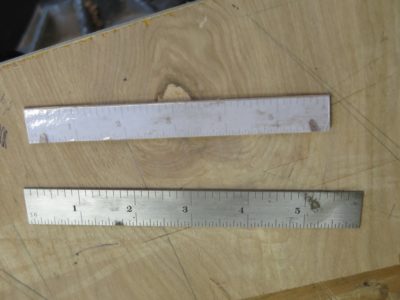
The top scale is one made from cutting out the photograph, the bottom scale is a 6-inch rule from my machinist’s tool kit.
Printing out one of the pictures representing the orientation I needed to make the handle (made from dalbergia, just like the original; I do not have much dalbergia so I might switch to swietenia mahoganii or another tropical hardwood at some point) with the scale included, I simply cut out the scale and used it to measure all the critical dimensions. As you can see the photographic representation of the scale differs greatly from the true scale, that difference is irrelevant because the image of the mallet itself is exactly the same scale as the photographed scale.

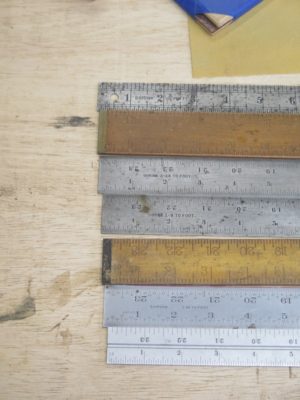
This exercise of using a “wrong sized” scale may be disconcerting to some, but it was the daily order of business when I was a patternmaker. The patternmaker’s tool kit includes a variety of rulers called “shrink scales.” These modified rules are used to lay out and construct a pattern to be used in making the molds for metal castings, and since each metal alloy shrinks a little bit when it solidifies the precise size of the pattern must reflect that reality.
At this point, especially as I create the handle, photogrammetry is more than a mere tool. It is the irreplaceable element.

Ever since moving to Shagri-la my favorite trimming mower has been an ancient Craftsman mower that was given to us by our friend SM when she lived with us for a few months back in Mordor. This is about the most basic lawnmower I ever encountered. There are no controls, really. There is a primer to pump gas into the carburetor to make sure the unit starts when the cord is yanked. That’s about it. For years and years it did the job for those areas around the edge, areas too close to the house or garden or whatever for the lawn tractor to fit there.

Recently I noticed it began to perform oddly, then it ceased to perform altogether even though the engine was running just fine. On closer examination I saw that the twin alignment pins on the hub had sheared off, as had the bolt that affixed the blade/hub to the engine shaft. And, the bolt had sheared off below the surrounding surface of the shaft.

My next task is to see if I can drill out the center of the broken bolt inside the shaft and try removing the broken bolt rod with a screw extractor. I hope this works as I have not seen any new mowers on the market that meet my desires.
Grrr. Stay tuned.





 Examining the original mallet in HO Studley’s tool ensemble and comparing it to the foundry practices I was taught 40+ years ago, several things came clearly(?) into focus. First and foremost, this might be the most exquisite sand casting I’ve ever seen. Certainly it was way better than anything our foundry produced, and I think we had a top-of-the-heap casting quality. On the iron/steel side of things the foundry could produce excellent castings up to a 10,000 pound heat size, and on the brass/bronze side the limit was about 600 pounds. The molders were first rate and experienced, the Pour Masters had been doing it since the Mezozoic Age, but even then our castings were nothing like that evident on Studley’s mallet.
Examining the original mallet in HO Studley’s tool ensemble and comparing it to the foundry practices I was taught 40+ years ago, several things came clearly(?) into focus. First and foremost, this might be the most exquisite sand casting I’ve ever seen. Certainly it was way better than anything our foundry produced, and I think we had a top-of-the-heap casting quality. On the iron/steel side of things the foundry could produce excellent castings up to a 10,000 pound heat size, and on the brass/bronze side the limit was about 600 pounds. The molders were first rate and experienced, the Pour Masters had been doing it since the Mezozoic Age, but even then our castings were nothing like that evident on Studley’s mallet.



















Recent Comments